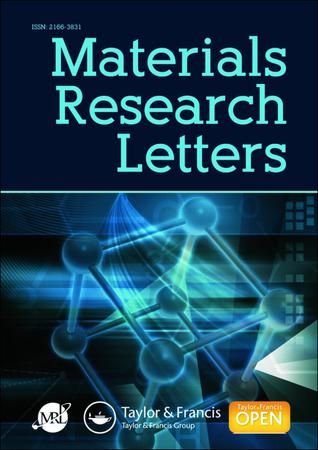高熵氧化物(Co,Cu,Mg,Ni,Zn)O表现出与晶粒尺寸相关的室温变形
IF 7.9
1区 材料科学
Q1 MATERIALS SCIENCE, MULTIDISCIPLINARY
引用次数: 2
摘要
尽管它们具有广阔的组成空间和有前途的性质,但对高熵氧化物(HEOs)的基本力学行为知之甚少。本文提供了不同晶粒尺寸(Co,Cu,Mg,Ni,Zn)O HEOs室温变形的纳米尺度来源的实验证据。我们发现微米晶(Co,Cu,Mg,Ni,Zn)O主要通过广泛的{1-10}位错滑移变形,表现为离散滑移带。纳米晶粒(Co,Cu,Mg,Ni,Zn)O除了适度的位错滑移活动外,还通过晶界滑动和晶间开裂进行变形。显著的位错介导的变形和晶粒尺寸依赖行为表明heo具有多样化和高度可定制的力学行为的潜力。高熵氧化物(Co,Cu,Mg,Ni,Zn)O表现出与晶粒尺寸相关的室温变形,其中微米晶样品表现出位错介导的显著变形潜力,纳米晶样品表现出晶界滑动和微裂纹。本文章由计算机程序翻译,如有差异,请以英文原文为准。
High entropy oxide (Co,Cu,Mg,Ni,Zn)O exhibits grain size dependent room temperature deformation
Despite their vast composition space and promising properties, little is known about the fundamental mechanical behavior of high entropy oxides (HEOs). Here we provide experimental evidence of the nanoscale origin of room temperature deformation in (Co,Cu,Mg,Ni,Zn)O HEOs with different grain sizes. We find that micron-grain (Co,Cu,Mg,Ni,Zn)O deforms predominately through extensive <110>{1–10} dislocation slip manifesting as discrete slip bands. Nano-grain (Co,Cu,Mg,Ni,Zn)O, in addition to moderate dislocation slip activity, deforms through grain boundary sliding and intergranular cracking. The significant dislocation-mediated deformation and grain size dependent behavior demonstrates that HEOs have the potential for diverse and highly tailorable mechanical behavior. GRAPHICAL ABSTRACT IMPACT STATEMENT High entropy oxides (Co,Cu,Mg,Ni,Zn)O exhibit grain size dependent room temperature deformation, with micron-grain samples displaying significant potential for dislocation-mediated deformation and nanocrystalline samples exhibiting grain boundary sliding and micro-cracking.
求助全文
通过发布文献求助,成功后即可免费获取论文全文。
去求助
来源期刊

Materials Research Letters
Materials Science-General Materials Science
CiteScore
12.10
自引率
3.60%
发文量
98
审稿时长
3.3 months
期刊介绍:
Materials Research Letters is a high impact, open access journal that focuses on the engineering and technology of materials, materials physics and chemistry, and novel and emergent materials. It supports the materials research community by publishing original and compelling research work. The journal provides fast communications on cutting-edge materials research findings, with a primary focus on advanced metallic materials and physical metallurgy. It also considers other materials such as intermetallics, ceramics, and nanocomposites. Materials Research Letters publishes papers with significant breakthroughs in materials science, including research on unprecedented mechanical and functional properties, mechanisms for processing and formation of novel microstructures (including nanostructures, heterostructures, and hierarchical structures), and the mechanisms, physics, and chemistry responsible for the observed mechanical and functional behaviors of advanced materials. The journal accepts original research articles, original letters, perspective pieces presenting provocative and visionary opinions and views, and brief overviews of critical issues.
 求助内容:
求助内容: 应助结果提醒方式:
应助结果提醒方式:


